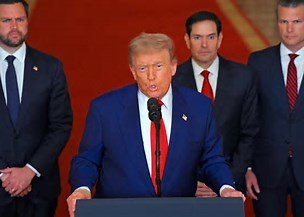On June 21, 2025, the United States formally entered the Iran-Israel conflict, launching coordinated precision strikes on Iran’s nuclear facilities at Fordow, Natanz, and Isfahan. Using B-2 stealth bombers and Tomahawk cruise missiles, the operation targeted the core of Iran’s uranium enrichment program. President Donald Trump declared the strikes a “spectacular military success,” claiming they “completely and totally obliterated” Iran’s nuclear capacity and were necessary to halt the threat posed by what he called the “world’s number one state sponsor of terror.”
Months of U.S.-facilitated negotiations via Oman had failed to persuade Iran to cease enrichment activities, prompting the administration to opt for military action. Despite the scale of the attacks, the International Atomic Energy Agency (IAEA) reported no detectable increase in off-site radiation, and Iranian officials stated no significant contamination occurred.
Iran Responds
Foreign Minister Abbas Araghchi labeled the U.S. strikes a “flagrant violation of international law” and warned of responses targeting U.S. bases in Qatar, the UAE, Bahrain, and Saudi Arabia.
High-ranking Iranian officials also floated the possibility of missile strikes on U.S. naval vessels and threatened to close the Strait of Hormuz, a vital global oil transit route. Despite these threats, Iran’s capacity for sustained counteroffensive is diminished—its air defenses and missile production capabilities were largely destroyed in prior Israeli operations, and its proxy network, including Hezbollah and Hamas, has been severely degraded.
Global Fallout
The United Nations Security Council convened an emergency session, with Secretary-General António Guterres calling the developments a “dangerous escalation.” Countries including Saudi Arabia, Oman, and India urged restraint, while China warned of “grave consequences” for global stability.
The IAEA confirmed significant structural damage to Iran’s Natanz facility but noted that Fordow’s deep underground location may have absorbed the worst of the strikes. Meanwhile, global oil markets surged, with Brent crude prices rising 7% amid fears of prolonged instability in the Persian Gulf. Economists warned that any blockade of the Strait of Hormuz could trigger widespread energy shortages and deepen existing economic pressures from U.S. trade policies.
Strategic Shift
The roots of the conflict stretch back decades, driven by Iran’s nuclear ambitions and Israel’s determination to prevent a nuclear-armed Tehran. Israel’s earlier precision strikes killed senior Iranian nuclear scientists and military leaders, prompting Tehran to escalate. The fall of Bashar al-Assad in Syria and the dismantling of Iran’s regional alliances have further weakened its strategic position.
Israel appears to be capitalizing on this moment of Iranian vulnerability. With Iran’s deterrent capabilities crippled and diplomatic channels closed, Jerusalem sees an opportunity to deliver a decisive blow. The U.S. strikes provided both tactical advantage and international cover for further Israeli operations.
On the Brink
Despite heavy losses on both sides, the threat of wider regional war looms large. Iran’s warnings about closing the Strait of Hormuz and striking U.S. assets heighten the risk of dragging Gulf states deeper into the conflict. Diplomatic prospects have dimmed following the collapse of nuclear talks and escalating rhetoric from both Tehran and Washington.
As Israel signals readiness for additional strikes and Iran prepares further responses, the Middle East teeters on the edge. The coming days may determine whether the region descends into full-scale war.
